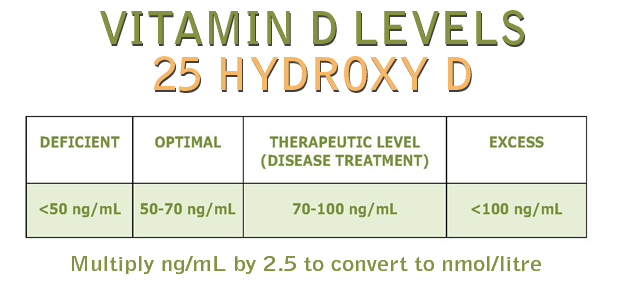Vitamin D Deficiency Symptoms You Can Identify Yourself
Doctors believed many decades ago that vitamin D was good only for healthy bones and teeth, but research has since proven otherwise. Vitamin D deficiency symptoms now have been linked to numerous health problems, including heart disease, depression, and even cancer.[1] In fact, a recent study conducted by Boston University researchers revealed vitamin D deficiency actually affects your DNA: “Any improvement in vitamin D status will significantly affect expression of genes that have a wide variety of biologic functions of more than 160 pathways linked to cancer, autoimmune disorders and cardiovascular disease.”
So, what are the signs of vitamin D deficiency?
First, you need to determine whether you have one or more vitamin D deficiency symptoms; they’re commonly overlooked and often dismissed as normal, everyday aches and pains. Next, you’ll order a vitamin D deficiency test (more on that below, or by clicking here).
Vitamin D Deficiency Symptoms: Common Ailments
Here’s a list of 10 of the most common symptoms of low vitamin D:
- Weight gain
- Bone softening (low bone density) or fractures
- Fatigue and generalized weakness
- Muscle cramps and weakness
- Joint pain (most noticeable in the back and knees)
- Blood sugar issues
- Low immunity
- Low calcium levels in the blood
- Mood changes and irritability
- Depression
Eat Right, Starting Now!
Download this expert FREE guide, Complete Nutrition: Low-carb diet, high-protein foods, healthy meal plans, how to use a calorie counter, and more.
Create healthy meal plans and discover the Superfoods that can transform your plate into a passport to better health.
Depression and Vitamin D Deficiency Symptoms
It’s No. 10 on the list above that we’ll examine more closely here. After all, the link between depression and vit D deficiency symptoms has long been established in both children and adults.
Vitamin D is available in two different forms–D3 and D2. Research has shown that the connection between vitamin D and depression relief is linked to the D3 form—the same form of vitamin D that is obtained through sunlight. Scientists have found that people with the lowest levels of vitamin D were 11 times more prone to be depressed than those who had normal levels.[2]
Vitamin D deficiency is actually more the norm than the exception, and has previously been implicated in both psychiatric and neurological disorders. Why? There are vitamin D receptors in the brain, and the vitamin may affect proteins in the brain known to play a role in mood, learning and memory, motor control, and possibly even maternal and social behavior.[3]
There may be more to your depression than low vitamin D levels. Other causes of depression include poor adrenal function (adrenal fatigue), neurotransmitter imbalance (serotonin and dopamine, for example), sex hormone imbalance (estrogen, testosterone), environmental factors, or other nutrient deficiencies (magnesium, for instance, and omega-3s).
Why Does It Matter If I Have Vitamin D Deficiency Symptoms?
Vitamin D is the superstar nutrient you don’t want to be without! Vitamin D deficiency symptoms in women and men, if left untreated, can lead to serious health problems such as:
- Osteopenia or osteoporosis
- Rickets in children
- Contracting the cold or the flu (weakened immune system)
- Asthma
- Tuberculosis
- Diabetes
- Periodontal disease
- Cardiovascular disease (high blood pressure and/or congestive heart failure)
- Major depressive disorder or seasonal affective disorder
- Multiple sclerosis
- Cancer
What Causes Vitamin D Deficiency Symptoms?
- Inadequate exposure to sunlight. Vitamin D is unlike any other vitamin because it is a “pro-hormone” produced in the skin with sunlight exposure. In particular, the sun is the main source of Vitamin D3, a type of vitamin D that increases levels of “feel-good” chemicals in the brain called dopamine and serotonin. (Deficient levels of either of these neurochemicals can be an underlying cause of depression.)
- Getting a lack vitamin D from your food. Although the sun’s rays are the primary source of vitamin D, the nutrient can also be found in foods such as fish (salmon, tuna, mackerel and cod), oysters, shrimp, beef liver and eggs.
- Age. As you age, your kidneys are less able to convert vitamin D to its active form, calcitriol, which can lead to a deficiency.
- Digestive Issues. Problems in the digestive tract can cause inadequate absorption of vitamin D.
- Obesity (Body Mass Index greater than 30). Vitamin D is extracted from the blood by fat cells. The more fat in the body, the less vitamin D is released into the circulation.
- Kidney or liver disease. Kidney and liver diseases can impair vitamin D conversion to its active form.
Testing for Vitamin D Deficiency Symptoms
If you suspect you have a deficiency of vitamin D —or you just want to know for sure—you should ask your doctor for a blood test called the 25-hydroxy vitamin D test (also called the 25-OH vitamin D test or Calcidiol 25-hydroxycholecalciferol test). This test is the most accurate way to measure how much vitamin D is in your body.
To prepare for the test, do not eat for four hours before your appointment. The ”normal” range for vitamin D per most lab reports is 30.0 to 74.0 nanograms per milliliter (ng/mL), but virtually all integrative physicians will recommended a minimum level of at least 50 ng/mL. Any levels below 20 ng/mL are considered serious deficiency states. To get an idea of just how widespread vitamin D deficiency is, consider that the late-winter average of 25-hydroxy vitamin D in the United States is only about 15–18 ng/mL. If you have depression, you are most likely vitamin D-deficient yourself.

You can also test your own vitamin D blood level without a doctor’s order by using one of the Direct to Consumer Testing Labs.
How to Reverse Vitamin D Deficiency Symptoms
Reversing vitamin D deficiency symptoms can be achieved using inexpensive natural remedies:
- Go out into the sun. Recommended sunlight exposure should be from 10 to 30 minutes per day. This is a great way of obtaining vitamin D3 and reversing vitamin D3 deficiency symptoms; not to mention, it’s very cost effective!
- If getting out in the sun is not an option for you, consider sitting in front of a light box that supplies 10,000 lux of full-spectrum light for 30 minutes every morning. This is an especially good option for winter months, for night shift workers, and for those who live in the upper latitudes where the angle of the sun’s rays do not permit complete production of vitamin D.
- Take supplements. For the vast majority of people who want to get their vitamin D levels consistently up above 50 ng/mL, supplementation is the easiest, safest, and most effective way to do so. Adults can take vitamin D3 (cholecalciferol) in regular capsule form at levels between 1000 IU and 5000 IU daily.
- Vitamin D3 is the most readily absorbable form. After a couple of months of supplementation, run the 25-hydroxy vitamin D blood test (by either your doctor or yourself directly) to make sure you’re not overdosing. Adjust your D3 intake accordingly. Although vitamin D overdosing is possible, the reality is far more people will need at least 5000 IU per day to keep their blood level above 50 ng/mL than those that will overdose.
- The inexpensive blood testing is the key to knowing where you stand. For children, multivitamins are available over-the-counter; these usually contain vitamin D. However, you should NOT give your child extra vitamin D supplements until consulting your family doctor, pediatrician or an integrative physician that has had specific nutritional training.
START NOW IN YOUR DEPRESSION RECOVERY
Remember, depression can be caused by multiple factors. Overcoming this illness usually takes more than one natural healing technique at a time. In addition to boosting your vitamin D levels, you’ll likely need to take additional supportive nutrients that work synergistically with vitamin D to beat depression for good. Look also to the types of natural depression strategies discussed in our post “8 Tips on How to Cure Depression.”
Tell Us How You Keep Your Vitamin D Levels Above 50 ng/mL
If you use vitamin D3 supplements, tell us about it. Share with us your daily dosage—how much do you take in order to feel good and keep your blood levels above 50 ng/mL?
What other techniques have you found effective in increasing your vitamin D levels?
Scroll down to the “Add Your Comments” section below and give your fellow readers some feedback and encouragement to help them with their vit d deficiency.
[1] JAMA, Nov. 14, 2012; 308(18).
[2] PLoS One. 2013;8(3):e58725.
[3] American Journal of Geriatric Psychiatry, December 2006; 14(12): 1032-1040.
[4] Arch Gen Psychiatry. 2008 May;65(5):508-12.
[5] Br J Psychiatry. 2013 Feb;202:100-7.
This article was originally published in 2013 and has been updated.
The post Vitamin D Deficiency Symptoms You Can Identify Yourself appeared first on University Health News.
Read Original Article: Vitamin D Deficiency Symptoms You Can Identify Yourself »
Powered by WPeMatico


